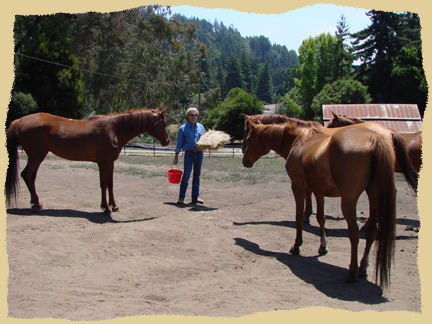
| Home > Clinics |
 |
|||
|
|||

Positive Reinforcement Horse Training Clinics
|
|
Our positive reinforcement horse training clinics help you develop a solid understanding of what makes your horse tick and how to use this information to develop unbelievable bonds, solve problems, and train all sorts of behaviors – from useful to just plain fun.
Your horse will learn to:
Horse training clinics span three days and all training
is done from the ground only. Why just groundwork in the beginning? Because
establishing
excellent
relationships and training behaviors from the ground first makes the transfer
to the saddle that much easier. Moreover, much of what we need to do with
horses
is on the ground and perfect ground manners are the key to safety for both
horse and human.
In a calm, relaxed, fun atmosphere, we teach you to teach your horse and once you understand the principles behind the practice you will be able to use this knowledge at any time and with any horse.
Using methods derived from our more than 25 years of scientific research into equine learning abilities, 10 years of previous cognition research with marine mammals, 10 years of studying Mustang behavior in the wild, as well as a lifetime of being with horses, we have developed a highly effective, gentle horse training system based on positive reinforcement (our version of clicker training), natural behavior, and a deep understanding of how horses think and learn.
These methods create horses that are eager to learn and unlock their abilities of learning to learn. Just about any horse responds well and the lessons learned are retained for life.
We do our horse training clinics by invitation, not by advanced scheduling. This means that if you would like to host or organize a clinic in your area we would be happy to come. In exchange for a free position in the clinic, you would find a suitable location and sign up a group of friends, neighbors, and other forward-thinking horse people.
We accept a minimum of 12 participants and a maximum of 15. Why limit it to only 15 when other clinicians have 30 or 40 horses and riders in an arena? Because, with positive reinforcement instruction, we want to make sure we can give enough individual attention to each participant and that’s impossible to do with large groups.
Any number of auditors are welcome.
Please contact us if setting up a positive reinforcement horse training clinic interests you. We will provide you with our promotional material including flyers, sign-up forms and questionnaires for participants.
Please note that our horse training clinics are not for colt starting.

The Equine Research Foundation positive reinforcement training tools are simple: a closeable belted pouch with outside pocket, a handheld target, a clicker with wrist coil for initial training, a stationary target (not shown), thin leather gloves, and food that horses like. And one more thing! A thorough understanding of the principles behind the practice of training with positive reinforcement and how to use food reinforcement properly.
The training tool starter kit (belted pouch, handheld target, clicker with wrist coil, and copies of our positive reinforcement articles - "Think . . . and Train . . . Positively!" and "Incredible, Edible Rewards") is currently only available to clinic participants. Please contact us or check back in the future to find out when kits will be available to nonparticipants.
Our positive reinforcement horse training methods and research findings have been published in scientific journals and national and international horse magazines, including the October and November 2006 issues of John Lyon’s Perfect Horse. Our research and training techniques have also been featured in lecture and video presentations at the 2005 Convention for the American Association of Equine Practitioners (AAEP).
Please see our horsemanship pictures page for an overview of our training methods and off-site horse training clinics plus see what people say about us.
Copyright Notice: All literature and photographs on this website are the exclusive property of the Equine Research Foundation or the scientific journals in which articles appear. The literature and photographs may not be downloaded or reproduced, copied, used or altered in any way without the written permission of the Equine Research Foundation.
![]()
|